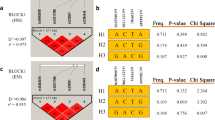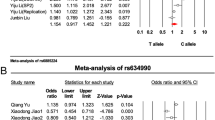Abstract
To investigate the association between insulin (INS) pathway related genes, including INS, insulin receptor (INSR), insulin receptor substrate 1 (IRS1), insulin-like growth factor 2 (IGF2), IGF2 receptor (IGF2R) and IGF binding protein 1 (IGFBP1), and high myopia (HM) in a Han Chinese population, we have genotyped 24 single nucleotide polymorphisms (SNPs) of these genes in this cohort by Sequenom MassARRAY method. The genotyping data was analyzed by χ2 test and the linkage disequilibrium block structure was examined by Haploview software. SNPs in the INS-IGF2 region (rs2070762 and rs1003483), and the INSR gene (rs3745551 and rs2229429) showed significant association with HM (allelic P = 0.0085, 0.0494, 0.0171 and 0.0238, respectively). Under the model of risk genotype combination of INSR and IRS1, carrying the variant allele (A) of the IRS1 Gly972Arg SNP (rs1801278) further increased the risk among the rs2229429T allele carriers (odds ratio 6.865, 95 % confidence interval 1.533–30.745). None of the SNPs in the IGF2R and IGFBP1 genes were found to be significantly associated with HM. Genetic variants in the insulin signaling pathway genes may increase the susceptibility of high myopia in Han Chinese.

Similar content being viewed by others
References
He M, Zeng J, Liu Y, Xu J, Pokharel GP, Ellwein LB (2004) Refractive error and visual impairment in urban children in Southern China. Invest Ophthalmol Vis Sci 45(3):793–799
Pan CW, Ramamurthy D, Saw SM (2012) Worldwide prevalence and risk factors for myopia. Ophthalmic Physiol Opt 32(1):3–16
He M, Zheng Y, Xiang F (2009) Prevalence of myopia in urban and rural children in mainland China. Optom Vis Sci 86(1):40–44
Morgan I, Rose K (2005) How genetic is school myopia? Prog Retin Eye Res 24(1):1–38
Sawada A, Tomidokoro A, Araie M, Iwase A, Yamamoto T (2008) Refractive errors in an elderly Japanese population: the Tajimi study. Ophthalmology 115(2):363–370
Wong TY, Foster PJ, Hee J, Ng TP, Tielsch JM, Chew SJ, Johnson GJ, Seah SK (2000) Prevalence and risk factors for refractive errors in adult Chinese in Singapore. Invest Ophthalmol Vis Sci 41(9):2486–2494
Vitale S, Sperduto RD, Ferris FL 3rd (2009) Increased prevalence of myopia in the United States between 1971–1972 and 1999–2004. Arch Ophthalmol 127(12):1632–1639
Kempen JH, Mitchell P, Lee KE, Tielsch JM, Broman AT, Taylor HR, Ikram MK, Congdon NG, O’Colmain BJ (2004) The prevalence of refractive errors among adults in the United States, Western Europe, and Australia. Arch Ophthalmol 122(4):495–505
Resnikoff S, Pascolini D, Mariotti SP, Pokharel GP (2008) Global magnitude of visual impairment caused by uncorrected refractive errors in 2004. Bull World Health Organ 86(1):63–70
Banker AS, Freeman WR (2001) Retinal detachment. Ophthalmol Clin North Am 14(4):695–704
Saw SM, Gazzard G, Shih-Yen EC, Chua WH (2005) Myopia and associated pathological complications. Ophthalmic Physiol Opt 25(5):381–391
Katz J, Tielsch JM, Sommer A (1997) Prevalence and risk factors for refractive errors in an adult inner city population. Invest Ophthalmol Vis Sci 38(2):334–340
Saw SM, Chua WH, Hong CY, Wu HM, Chan WY, Chia KS, Stone RA, Tan D (2002) Nearwork in early-onset myopia. Invest Ophthalmol Vis Sci 43(2):332–339
Ip JM, Saw SM, Rose KA, Morgan IG, Kifley A, Wang JJ, Mitchell P (2008) Role of near work in myopia: findings in a sample of Australian school children. Invest Ophthalmol Vis Sci 49(7):2903–2910
Rose KA, Morgan IG, Ip J, Kifley A, Huynh S, Smith W, Mitchell P (2008) Outdoor activity reduces the prevalence of myopia in children. Ophthalmology 115(8):1279–1285
Saw SM, Hong CY, Chia KS, Stone RA, Tan D (2001) Nearwork and myopia in young children. Lancet 357(9253):390
Young TL, Metlapally R, Shay AE (2007) Complex trait genetics of refractive error. Arch Ophthalmol 125(1):38–48
Morgan IG, Ohno-Matsui K, Saw SM (2012) Myopia. Lancet 379(9827):1739–1748
Ma JH, Shen SH, Zhang GW, Zhao DS, Xu C, Pan CM, Jiang H, Wang ZQ, Song HD (2010) Identification of a locus for autosomal dominant high myopia on chromosome 5p13.3–p15.1 in a Chinese family. Mol Vis 16:2043–2054
Shi Y, Qu J, Zhang D, Zhao P, Zhang Q, Tam PO, Sun L, Zuo X, Zhou X, Xiao X, Hu J, Li Y, Cai L, Liu X, Lu F, Liao S, Chen B, He F, Gong B, Lin H, Ma S, Cheng J, Zhang J, Chen Y, Zhao F, Yang X, Yang C, Lam DS, Li X, Shi F, Wu Z, Lin Y, Yang J, Li S, Ren Y, Xue A, Fan Y, Li D, Pang CP, Zhang X, Yang Z (2011) Genetic variants at 13q12.12 are associated with high myopia in the Han Chinese population. Am J Hum Genet 88(6):805–813
Shi Y, Li Y, Zhang D, Zhang H, Lu F, Liu X, He F, Gong B, Cai L, Li R, Liao S, Ma S, Lin H, Cheng J, Zheng H, Shan Y, Chen B, Hu J, Jin X, Zhao P, Chen Y, Zhang Y, Lin Y, Li X, Fan Y, Yang H, Wang J, Yang Z (2011) Exome sequencing identifies ZNF644 mutations in high myopia. PLoS Genet 7(6):e1002084
Baird PN, Schache M, Dirani M (2010) The Genes in Myopia (GEM) study in understanding the aetiology of refractive errors. Prog Retin Eye Res 29(6):520–542. doi:10.1016/j.preteyeres.2010.05.004
Young TL (2009) Molecular genetics of human myopia: an update. Optom Vis Sci 86(1):E8–E22
Feldkaemper MP, Neacsu I, Schaeffel F (2009) Insulin acts as a powerful stimulator of axial myopia in chicks. Invest Ophthalmol Vis Sci 50(1):13–23
Gosbell AD, Favilla I, Baxter KM, Jablonski P (2000) Insulin receptor and insulin receptor substrate-I in rat retinae. Clin Exp Ophthalmol 28(3):212–215
Metlapally R, Ki CS, Li YJ, Tran-Viet KN, Abbott D, Malecaze F, Calvas P, Mackey DA, Rosenberg T, Paget S, Guggenheim JA, Young TL (2010) Genetic association of insulin-like growth factor-1 polymorphisms with high-grade myopia in an international family cohort. Invest Ophthalmol Vis Sci 51(9):4476–4479
Rydzanicz M, Nowak DM, Karolak JA, Frajdenberg A, Podfigurna-Musielak M, Mrugacz M, Gajecka M (2011) IGF-1 gene polymorphisms in Polish families with high-grade myopia. Mol Vis 17:2428–2439
Mak JY, Yap MK, Fung WY, Ng PW, Yip SP (2012) Association of IGF1 gene haplotypes with high myopia in Chinese adults. Arch Ophthalmol 130(2):209–216
Zhuang W, Yang P, Li Z, Sheng X, Zhao J, Li S, Yang X, Xiang W, Rong W, Liu Y, Zhang F (2012) Association of insulin-like growth factor-1 polymorphisms with high myopia in the Chinese population. Mol Vis 18:634–644
Tang RH, Tan J, Deng ZH, Zhao SZ, Miao YB, Zhang WJ (2012) Insulin-like growth factor-2 antisense oligonucleotides inhibits myopia by expression blocking of retinal insulin-like growth factor-2 in guinea pig. Clin Exp Ophthalmol 40(5):503–511
Deng ZH, Tan J, Liu SZ, Zhao SZ, Wang JT (2010) The correlation between the regulation of recombinant human IGF-2 on eye growth and form-deprivation in guinea pig. Graefes Arch Clin Exp Ophthalmol 248(4):519–525
Smith AV (2008) Manipulating HapMap Data Using HaploView. CSH Protoc 2008:pdb prot5025
Wagner K, Hemminki K, Grzybowska E, Klaes R, Butkiewicz D, Pamula J, Pekala W, Zientek H, Mielzynska D, Siwinska E, Forsti A (2004) The insulin-like growth factor-1 pathway mediator genes: SHC1 Met300Val shows a protective effect in breast cancer. Carcinogenesis 25(12):2473–2478
Ritchie MD, Hahn LW, Roodi N, Bailey LR, Dupont WD, Parl FF, Moore JH (2001) Multifactor-dimensionality reduction reveals high-order interactions among estrogen-metabolism genes in sporadic breast cancer. Am J Hum Genet 69(1):138–147
Pechlivanis S, Pardini B, Bermejo JL, Wagner K, Naccarati A, Vodickova L, Novotny J, Hemminki K, Vodicka P, Forsti A (2007) Insulin pathway related genes and risk of colorectal cancer: INSR promoter polymorphism shows a protective effect. Endocr Relat Cancer 14(3):733–740
Barrett JC, Fry B, Maller J, Daly MJ (2005) Haploview: analysis and visualization of LD and haplotype maps. Bioinformatics 21(2):263–265
Gabriel SB, Schaffner SF, Nguyen H, Moore JM, Roy J, Blumenstiel B, Higgins J, DeFelice M, Lochner A, Faggart M, Liu-Cordero SN, Rotimi C, Adeyemo A, Cooper R, Ward R, Lander ES, Daly MJ, Altshuler D (2002) The structure of haplotype blocks in the human genome. Science 296(5576):2225–2229
Kusakari T, Sato T, Tokoro T (2001) Visual deprivation stimulates the exchange of the fibrous sclera into the cartilaginous sclera in chicks. Exp Eye Res 73(4):533–546
Penha AM, Schaeffel F, Feldkaemper M (2011) Insulin, insulin-like growth factor-1, insulin receptor, and insulin-like growth factor-1 receptor expression in the chick eye and their regulation with imposed myopic or hyperopic defocus. Mol Vis 17:1436–1448
Malodobra M, Pilecka A, Gworys B, Adamiec R (2011) Single nucleotide polymorphisms within functional regions of genes implicated in insulin action and association with the insulin resistant phenotype. Mol Cell Biochem 349(1–2):187–193
Sachdev D, Yee D (2007) Disrupting insulin-like growth factor signaling as a potential cancer therapy. Mol Cancer Ther 6(1):1–12
Pavelic K, Bukovic D, Pavelic J (2002) The role of insulin-like growth factor 2 and its receptors in human tumors. Mol Med 8(12):771–780
Killian JK, Oka Y, Jang HS, Fu X, Waterland RA, Sohda T, Sakaguchi S, Jirtle RL (2001) Mannose 6-phosphate/insulin-like growth factor 2 receptor (M6P/IGF2R) variants in American and Japanese populations. Hum Mutat 18(1):25–31
Almind K, Inoue G, Pedersen O, Kahn CR (1996) A common amino acid polymorphism in insulin receptor substrate-1 causes impaired insulin signaling. Evidence from transfection studies. J Clin Invest 97(11):2569–2575
Kadowaki T, Kadowaki H, Rechler MM, Serrano-Rios M, Roth J, Gorden P, Taylor SI (1990) Five mutant alleles of the insulin receptor gene in patients with genetic forms of insulin resistance. J Clin Invest 86(1):254–264
Acknowledgments
We thank the patients and their families for their participation. This work was supported by grants from the National Basic Research Program of China (973 Program, 2011CB504604 to ZY); the Natural Science Foundation of China (81271047 to XL; 81170882 to YS; 81170883 to ZY; 81100693 to CQ; 81070761 and 81241001 to FL); the Department of Science and Technology of Sichuan Province (2012JQ0023 to YS); the Department of Sichuan Provincial Health (120121 to XL).
Conflict of Interest
All authors have declared that they have no conflict of interest.
Author information
Authors and Affiliations
Corresponding author
Additional information
Xiaoqi Liu, Pu Wang, Chao Qu and Hong Zheng have contributed equally to this work.
Rights and permissions
About this article
Cite this article
Liu, X., Wang, P., Qu, C. et al. Genetic association study between INSULIN pathway related genes and high myopia in a Han Chinese population. Mol Biol Rep 42, 303–310 (2015). https://doi.org/10.1007/s11033-014-3773-6
Received:
Accepted:
Published:
Issue Date:
DOI: https://doi.org/10.1007/s11033-014-3773-6




